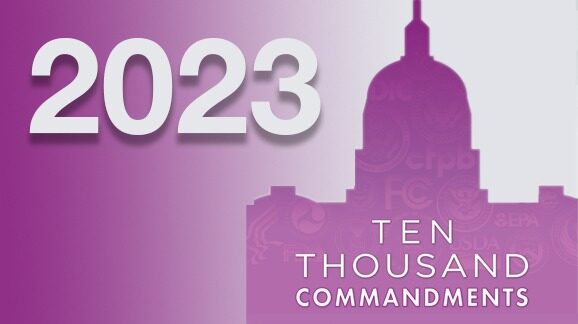Chapter 9: A Note on Rule Reviews at OMB’s Office of Information and Regulatory Affairs
Tracking the effects of rules and regulations, executive orders, memoranda, and regulatory guidance is vital. These alternative regulatory actions have become powerful means of working around the constitutional system of government the Framers envisioned: legislation enacted by elected representatives.
OMB’s mission drift is obvious when comparing Trump’s “one-in, two-out” emphasis with Biden’s directing OMB to search for “net benefits” as defined by progressives. The shift from analysis to cheerleading shows the need for Congress to define parameters of regulatory review in a way that the executive cannot tamper with it.
Nevertheless, the number of Executive Order 12866 rule reviews that take place, whatever transformed motivations govern behind the scenes since its publication, is one of the metrics Congress will need to watch. Figure 18 presents the 485 rule reviews conducted by OMB during calendar year 2022, broken down by stage and by economic significance.

There were 503 total reviews in Biden’s first year and 669 in Trump’s final year. Under Biden, 2022’s economically significant rules reviewed stood at 161, down from 172 in 2021. Figure 18 also shows the number of days OMB took to review significant and nonsignificant rules and regulations, a process that tends to take just over two months. During the pre–Executive Order 12866 years of 1991–1993 (see Appendix: Historical Tables, Part D), rule review times were shorter than today, despite the number of rules issued being considerably higher back then. Interim final rules reviewed by OMB now stand at just 24 compared with 58 during Biden’s first year and 77 during Trump’s last. These had numbered only 12 and 11 in Trump’s first two years, respectively. Prerule reviews dropped from 30 to just 18 over the past year (see Figure 18 and Appendix: Historical Tables, Part D).
Although agencies issued thousands of notices, Figure 18 shows that OMB reviewed just 103 during calendar year 2022. That is up from 72 in 2021 and comparable to Trump’s 104 upon exit. Low as these are, they are still higher than the few dozen seen in most years since 1993. A history of the number of rules and notices reviewed annually by the White House Office of Information and Regulatory Affairs appears in Appendix: Historical Tables, Part D, which presents a detailed breakdown of rules reviewed by type and by average days for review from 1991 through 2021. In recent years, several dozen of the notices OMB reviewed were deemed to have economically significant effects.
The president and Congress can ensure that adequate review and supervision of guidance documents and notices take place by investigating OMB conclusion actions, such as whether and what kinds of rules were or were not returned to agencies for modification, and for what kinds of modifications.
